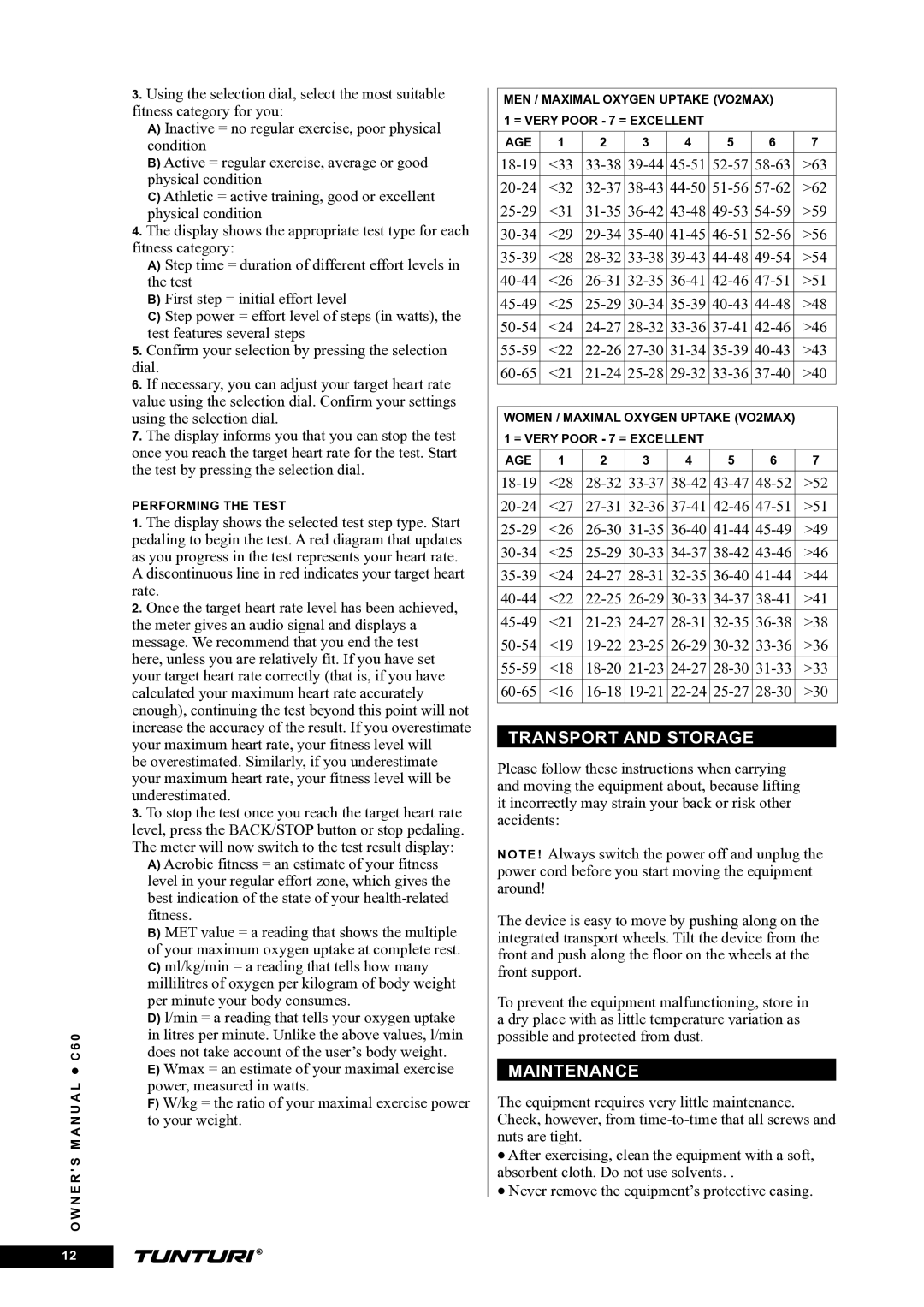
O W N E R ' S M A N U A L • C 6 0
3.Using the selection dial, select the most suitable fitness category for you:
A)Inactive = no regular exercise, poor physical condition
B)Active = regular exercise, average or good physical condition
C)Athletic = active training, good or excellent physical condition
4.The display shows the appropriate test type for each fitness category:
A)Step time = duration of different effort levels in the test
B)First step = initial effort level
C)Step power = effort level of steps (in watts), the test features several steps
5.Confirm your selection by pressing the selection dial.
6.If necessary, you can adjust your target heart rate value using the selection dial. Confirm your settings using the selection dial.
7.The display informs you that you can stop the test once you reach the target heart rate for the test. Start the test by pressing the selection dial.
PERFORMING THE TEST
1.The display shows the selected test step type. Start pedaling to begin the test. A red diagram that updates as you progress in the test represents your heart rate. A discontinuous line in red indicates your target heart rate.
2.Once the target heart rate level has been achieved, the meter gives an audio signal and displays a message. We recommend that you end the test here, unless you are relatively fit. If you have set your target heart rate correctly (that is, if you have calculated your maximum heart rate accurately enough), continuing the test beyond this point will not increase the accuracy of the result. If you overestimate your maximum heart rate, your fitness level will
be overestimated. Similarly, if you underestimate your maximum heart rate, your fitness level will be underestimated.
3.To stop the test once you reach the target heart rate level, press the BACK/STOP button or stop pedaling. The meter will now switch to the test result display:
A)Aerobic fitness = an estimate of your fitness level in your regular effort zone, which gives the best indication of the state of your
B)MET value = a reading that shows the multiple of your maximum oxygen uptake at complete rest.
C)ml/kg/min = a reading that tells how many millilitres of oxygen per kilogram of body weight per minute your body consumes.
D)l/min = a reading that tells your oxygen uptake in litres per minute. Unlike the above values, l/min does not take account of the user’s body weight.
E)Wmax = an estimate of your maximal exercise power, measured in watts.
F)W/kg = the ratio of your maximal exercise power to your weight.
MEN / MAXIMAL OXYGEN UPTAKE (VO2MAX) 1 = VERY POOR - 7 = EXCELLENT
AGE | 1 | 2 | 3 | 4 | 5 | 6 | 7 | ||||
<33 | >63 | ||||||||||
<32 | >62 | ||||||||||
<31 | >59 | ||||||||||
<29 | >56 | ||||||||||
<28 | >54 | ||||||||||
<26 | >51 | ||||||||||
<25 | >48 | ||||||||||
<24 | >46 | ||||||||||
<22 | >43 | ||||||||||
<21 | >40 | ||||||||||
|
|
|
|
|
|
|
| ||||
WOMEN / MAXIMAL OXYGEN UPTAKE (VO2MAX) |
| ||||||||||
1 = VERY POOR - 7 = EXCELLENT |
|
|
|
|
| ||||||
AGE | 1 | 2 |
| 3 |
| 4 |
| 5 |
| 6 | 7 |
<28 | >52 | ||||||||||
<27 | >51 | ||||||||||
<26 | >49 | ||||||||||
<25 | >46 | ||||||||||
<24 | >44 | ||||||||||
<22 | >41 | ||||||||||
<21 | >38 | ||||||||||
<19 | >36 | ||||||||||
<18 | >33 | ||||||||||
<16 | >30 | ||||||||||
TRANSPORT AND STORAGE
Please follow these instructions when carrying and moving the equipment about, because lifting it incorrectly may strain your back or risk other accidents:
NOTE! Always switch the power off and unplug the power cord before you start moving the equipment around!
The device is easy to move by pushing along on the integrated transport wheels. Tilt the device from the front and push along the floor on the wheels at the front support.
To prevent the equipment malfunctioning, store in a dry place with as little temperature variation as possible and protected from dust.
MAINTENANCE
The equipment requires very little maintenance. Check, however, from
•After exercising, clean the equipment with a soft, absorbent cloth. Do not use solvents. .
•Never remove the equipment’s protective casing.
12
